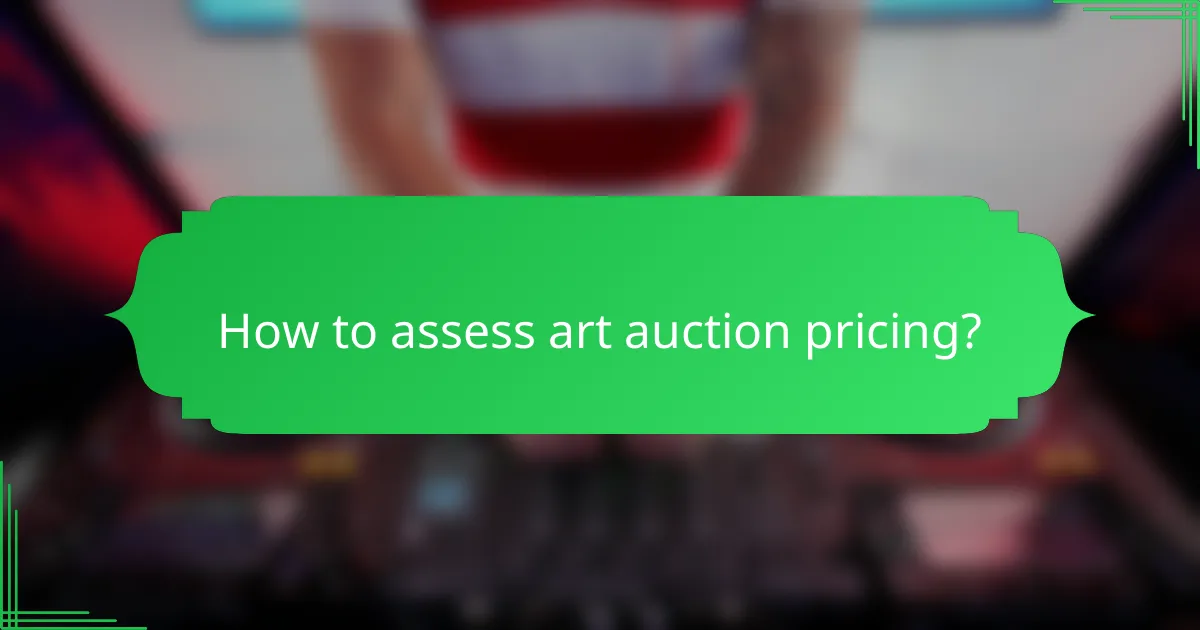Art auctions represent a dynamic marketplace where competitive bidding drives the sale of unique artworks to the highest bidder. Participants must navigate various strategies and psychological tactics to secure pieces at optimal prices, while understanding key factors like provenance and market demand is essential for informed decision-making.

How do art auctions work in the UK?
Art auctions in the UK involve a competitive bidding process where buyers place bids on artworks, often culminating in a sale to the highest bidder. These auctions are typically conducted by established auction houses and can take place in person or online.
Overview of auction processes
The auction process begins with the auction house cataloging the artworks, providing details such as provenance, condition, and estimated value. Interested buyers can preview the items before the auction, allowing them to assess the pieces they wish to bid on.
During the auction, an auctioneer leads the bidding, starting at a minimum price and encouraging participants to place higher bids. Bidders can raise their paddles or click buttons in online settings, and the auction concludes when no further bids are placed, resulting in a sale to the highest bidder.
Key players in art auctions
Key players in art auctions include auction houses, which facilitate the sale, and consignors, who are the sellers of the artworks. Buyers, often collectors or investors, play a crucial role as they determine the final sale price through their bids.
Additionally, art advisors and specialists may assist buyers and sellers in navigating the auction process, providing insights on market trends and pricing strategies. Understanding the roles of these players can enhance the auction experience and outcomes.
Types of art auctions
Art auctions can be categorized into several types, including traditional live auctions, online auctions, and sealed-bid auctions. Live auctions are conducted in real-time, often featuring an energetic atmosphere, while online auctions allow participants to bid remotely over a specified period.
Sealed-bid auctions involve bidders submitting confidential bids, with the highest bid winning without a public bidding process. Each type has its advantages, such as convenience in online auctions or the excitement of live events, and choosing the right format can impact bidding strategies and outcomes.

What are competitive bidding strategies?
Competitive bidding strategies are approaches used by bidders in auctions to secure art pieces at favorable prices while navigating the dynamics of competition. These strategies involve understanding the auction environment, employing specific tactics, and leveraging psychological insights to enhance bidding effectiveness.
Understanding bidding tactics
Bidding tactics refer to the methods employed by participants to outmaneuver competitors during an auction. Key tactics include setting a maximum bid limit, observing competitors’ behavior, and timing bids strategically. For instance, some bidders may wait until the last moments of the auction to place their bids, creating a sense of urgency.
It’s essential to analyze the auction format—whether it’s a live auction or an online platform—as this can influence the effectiveness of different tactics. Familiarizing oneself with the auctioneer’s style can also provide insights into when to bid aggressively or hold back.
Common bidding techniques
Several common bidding techniques can be employed to gain an advantage. One popular method is the “proxy bidding” technique, where bidders set their maximum bid in advance, allowing the system to automatically increase their bid incrementally. This can prevent emotional overbidding and keep the focus on the target price.
Another technique is the “escalation” strategy, where bidders gradually increase their bids to gauge the competition’s limits. This method can help identify how much others are willing to pay, allowing for more informed bidding decisions. Additionally, some bidders may use “group bidding,” where they collaborate with others to increase their chances of winning a desired piece.
Psychological aspects of bidding
The psychological aspects of bidding play a significant role in competitive auctions. Bidders often experience emotions such as excitement, anxiety, and even fear of loss, which can influence their decision-making. Understanding these emotions can help bidders maintain composure and stick to their strategies.
Additionally, the concept of “social proof” can impact bidding behavior. When bidders observe others actively participating, they may feel compelled to join in, sometimes leading to irrational bidding. To counteract this, bidders should establish a clear budget and bidding strategy beforehand, ensuring they remain focused on their goals rather than getting swept up in the competitive atmosphere.

How to assess art auction pricing?
Assessing art auction pricing involves understanding various factors that influence the final bid, including the artwork’s provenance, condition, and market demand. Evaluating these elements can help buyers and sellers make informed decisions during the auction process.
Factors influencing auction prices
Several key factors can significantly impact auction prices. The artist’s reputation, the rarity of the piece, and its historical significance are primary considerations. Additionally, the artwork’s condition and any accompanying documentation, such as certificates of authenticity, can either enhance or detract from its value.
Market trends also play a crucial role; for instance, a surge in interest for a particular artist can drive prices higher. Seasonal factors, such as the timing of the auction and competing events, can also affect bidding behavior.
Comparative market analysis
Conducting a comparative market analysis involves reviewing recent sales of similar artworks to gauge potential pricing. This process includes examining auction results, gallery sales, and private transactions to establish a baseline for expected prices. Online platforms and auction house databases can provide valuable insights into current market conditions.
When analyzing comparable sales, consider factors such as the medium, size, and condition of the artworks. This approach helps to create a realistic price range and informs bidding strategies during the auction.
Historical price trends
Understanding historical price trends is essential for assessing art auction pricing. Tracking how specific artists or styles have performed over time can reveal patterns that may influence future values. For example, artworks by emerging artists may initially sell for lower prices but can appreciate significantly as their reputation grows.
Utilizing resources like auction house archives or art market reports can help identify these trends. Be aware that economic conditions and cultural shifts can also impact historical pricing, making it crucial to consider broader market dynamics when evaluating potential auction prices.

What are the best platforms for art auctions in the UK?
The best platforms for art auctions in the UK include a mix of established online auction houses and local galleries. Each platform offers unique features and benefits, catering to different types of buyers and sellers in the art market.
Popular online auction houses
Online auction houses like Sotheby’s, Christie’s, and Bonhams dominate the UK art auction scene. These platforms provide a wide range of artworks, from contemporary pieces to classic masterpieces, and often feature high-profile auctions.
Buyers can participate in live auctions or place bids in timed online events, making it convenient to engage from anywhere. Fees typically range from 5% to 25% of the final sale price, depending on the platform and the value of the artwork.
Local auction galleries
Local auction galleries, such as Phillips and smaller regional houses, offer a more personalized experience. These venues often focus on specific art styles or local artists, providing a unique opportunity to discover emerging talent.
Participating in local auctions can also foster a sense of community among art enthusiasts. Bidding fees at these galleries may be lower than those at larger houses, often falling between 10% and 20% of the sale price.
Comparison of auction platforms
| Platform Type | Examples | Fees | Special Features |
|---|---|---|---|
| Online Auction Houses | Sotheby’s, Christie’s, Bonhams | 5% – 25% | Global reach, high-value auctions |
| Local Auction Galleries | Phillips, regional houses | 10% – 20% | Community focus, emerging artists |
When choosing an auction platform, consider factors such as the type of art you are interested in, the associated fees, and the level of service provided. Each platform has its strengths, so aligning your goals with the right venue is essential for a successful auction experience.

What criteria should be considered when choosing an auction house?
When selecting an auction house, consider its reputation, fee structure, and specialization in specific art types. These factors can significantly influence your experience and the potential success of your auction.
Reputation and track record
The reputation of an auction house is crucial as it reflects its credibility and the trust it has built within the art community. Look for houses with a strong history of successful sales and satisfied clients. Research their past auctions to see how well they performed in terms of sale prices and buyer engagement.
Check for reviews and testimonials from previous sellers and buyers. A well-regarded auction house often has a portfolio showcasing high-profile sales, which can indicate a robust network of potential buyers.
Fees and commissions
Understanding the fee structure of an auction house is essential for budgeting your auction experience. Most auction houses charge a seller’s commission, typically ranging from 5% to 25% of the final sale price, along with additional fees for marketing and handling.
Be aware of buyer’s premiums, which are added to the hammer price and can range from 10% to 25%. These costs can significantly affect the final amount you receive or the total price a buyer pays, so ensure you factor them into your decision-making process.
Specialization in art types
Choose an auction house that specializes in the type of art you are selling or buying. Some houses focus on contemporary art, while others may specialize in antiques or specific genres like photography or sculpture. This specialization can attract a more targeted audience, increasing the likelihood of a successful sale.
Research the auction house’s expertise in your art category by reviewing their past auctions and the types of works they typically handle. A specialized auction house may also provide better marketing strategies and insights into current market trends for your specific art type.

What are the emerging trends in the art auction market?
The art auction market is experiencing significant changes driven by technology, evolving buyer demographics, and the balance between live and online auctions. Understanding these trends can help both buyers and sellers navigate this dynamic landscape effectively.
Impact of digital technology
Digital technology is reshaping the art auction market by enhancing accessibility and engagement. Online platforms allow bidders from around the world to participate in auctions without geographical constraints, increasing competition and driving prices higher.
Additionally, virtual reality and augmented reality tools are being used to create immersive viewing experiences, enabling potential buyers to examine artworks closely before placing bids. This technological shift is making art more accessible to a broader audience.
Shifts in buyer demographics
The demographics of art buyers are evolving, with younger collectors increasingly entering the market. Millennials and Gen Z buyers are more inclined to purchase art online and are often motivated by investment potential as well as personal enjoyment.
This shift is prompting auction houses to adapt their marketing strategies, focusing on social media and digital engagement to attract these new buyers. Understanding the preferences of these demographics is crucial for sellers aiming to reach this growing audience.
Future of live vs online auctions
The future of art auctions appears to be a hybrid model that combines both live and online formats. While live auctions provide a traditional and thrilling atmosphere, online auctions offer convenience and broader participation.
As auction houses refine their strategies, they may implement features like live streaming for online bidders, allowing them to experience the excitement of live auctions from anywhere. This blend is likely to cater to diverse preferences, ensuring that both formats remain relevant in the evolving market.
